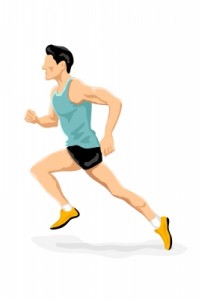 This is a guest post written by David Dack.
This is a guest post written by David Dack.
When it comes to proper running recovery, practicing the right strategies over the long haul is key for performance and consistency. Unfortunately, most runners shy away from proper recovery practices, thus leading them to face setbacks and performance plateaus.
Therefore, here are 2 keys to proper recovery and how to implement them.
Cool Down Right
A decent cool down is your first step toward proper running recovery. Stopping on the spot can leave you feeling dizzy, shaky and increases the likelihood of soreness and injury. However, gradually decreasing your running speed and intensity for a few minutes helps you ward off most of the trouble.
In addition, a cool down improves your running experience by granting you the time to reflect back on your workout and assess the different ways by which you can further enhance your training program.
Therefore, make sure to gradually reduce your running pace into an effortless jog. The duration of the cool down depends, for the most part, on the intensity and/or length of the run. The harder and intense you run, the more cool-down time your body will need. As long as you’re getting your heart and breathing rates back to their normal, you’re cooling down right.
Stretching for Recovery
Most runners manage to throw in a couple of stretches after a running session, but is that enough for aiding and speeding up recovery? Hell no. the repetitive high impact nature of running forces the muscles to contract constantly, thus the fibers become tight and sometime misaligned following a running session. As a result, if you don’t get the fibers back to their resting length, you run the risk of feeling tight and sore on your next workout, thus compromising training enjoyment and increasing the likelihood of discomforts and even injury.
Neglecting proper post-run stretching over the long-term causes adaptive shortening, meaning that muscle fibers can permanently lose length, thus compromising the proper functioning of the joints they attach to. Therefore, make sure to implement the right stretching routine to your running program, otherwise be ready to suffer the dire consequences.
Ideally, you ought to stretch all the major lower body muscles, especially the quads, hip flexors and hamstrings; make sure also to stretch your lower back and any other tensed area. Hold each stretch for 20-30 seconds and breathe deeply to release any built-up tension or discomfort. If you’re looking for more, shoot for a 30-minute yoga session. Yoga will not only help get more flexible, it will also help you recover faster while still building strength and stamina.
Try these two stretches for maximum recovery:
- For the hip flexors:
- Take a big step forward with your right foot while bending the knee;
- Rest your left knee gently on the floor;
- Get your torso upright, then gradually and gently press the left hip forward;
- Release any tension in the area, then switch to the other side.
- For the hamstrings:
- Stand in front of low chair (or any other mid shin support);
- Put your right foot on the support with the leg straight;
- Lean forward from the hips until you start feeling the stretch along the back of the thigh;
- Repeat the stretch on the other side.
About the Author
David DACK is a runner and an established author on weight loss, motivation and fitness. If you want more free tips from David DACK, then go to http://runnersblueprint.com/.
Image courtesy of digitalart / FreeDigitalPhotos.net
I use the the above hamstring stretch often after my biking and boxing workout.
Thanks for sharing what you do!
Take care,
Evelyn
thanks for such a brilliant insight….apprciate the fact tht u’ve foccussed on a subject which most ppl tend to neglect…”post running recovery”….would d same method be applicable in case of “spot running”??
Hi, David! I work out daily, most of the time, but when I began, or when I start again after a break, I feel the pain in all my body. I understand now what was the problem: not stretching.
So true, One hint that a post cardio warm down was too brief is if your feet feel afire. Hot feet mean blood is still pumping out of the heart to the feet at a workout rate yet not getting pumped back up since the legs are no longer moving. When we stop too quickly, gravity takes over and the warm blood stays in our feet as skeletal muscle movement no longer pumps it back up.
Hey Kymberly!
Wow, thanks for sharing about the feet feeling afire. Didn’t know that. I’ll be sure to keep this in mind when I am jogging.
Take care,
Evelyn